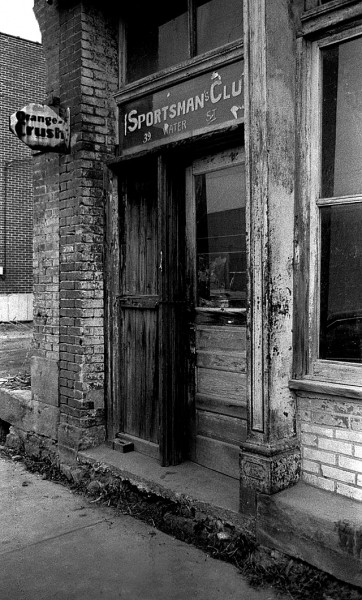 I shot the doorway to the Sportsman’s Club at 39 North Water Street when I was going through one of my periodic “peeling paint” phases. I didn’t know anything about the Sportsman’s Club, I just thought it was neat. It was probably shot around 1966.
I shot the doorway to the Sportsman’s Club at 39 North Water Street when I was going through one of my periodic “peeling paint” phases. I didn’t know anything about the Sportsman’s Club, I just thought it was neat. It was probably shot around 1966.
Sportsman’s Club in 2009?
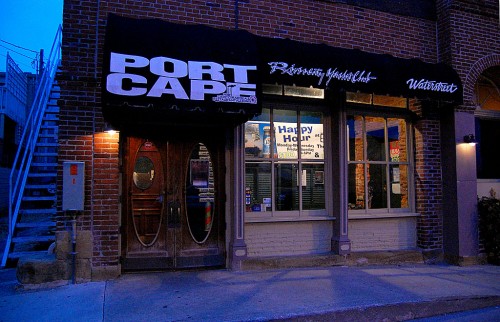 When I went walking down Water Street in 2009, I carried a copy of the photo with me to see if I could shoot a before and after picture. I thought it looked like it had become the back entrance to Port Cape. The door post at the right looks the same, only in better condition; there are two courses of brick on the left side of the door and an open space with a foundation stone sticking out.
When I went walking down Water Street in 2009, I carried a copy of the photo with me to see if I could shoot a before and after picture. I thought it looked like it had become the back entrance to Port Cape. The door post at the right looks the same, only in better condition; there are two courses of brick on the left side of the door and an open space with a foundation stone sticking out.
39 North Water St. collapsed in 1968
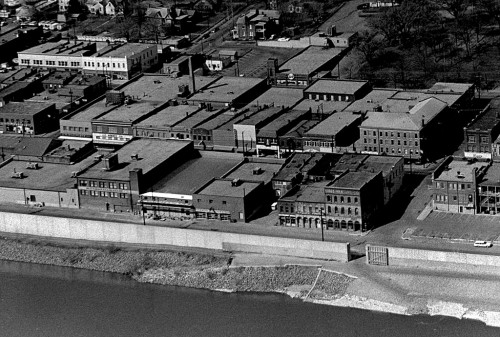 I was surprised to run across an October 16, 1968, Missourian story that said the front part of the building at 39 North Water Street had collapsed. Workers for Gerhardt Construction said the two-story brick structure apparently caved in from the roof because of its old age.
I was surprised to run across an October 16, 1968, Missourian story that said the front part of the building at 39 North Water Street had collapsed. Workers for Gerhardt Construction said the two-story brick structure apparently caved in from the roof because of its old age.
How could something collapse in 1968, but still be around in 2009? This aerial photo of that block, taken before 1968, shows the three-story building that became Port Cape on the right. To its left, next to the parking lot that looks like a missing tooth, is a two-story building with three windows. Sandwiched in the middle is a two-story building with five windows.
It sounds like the 39 Water Street building collapsed from the middle in, spilling some bricks into the street, but leaving at least the front wall partially intact. It must have been rebuilt as a one-story building.
Problems with “Negro” Sunday night dances
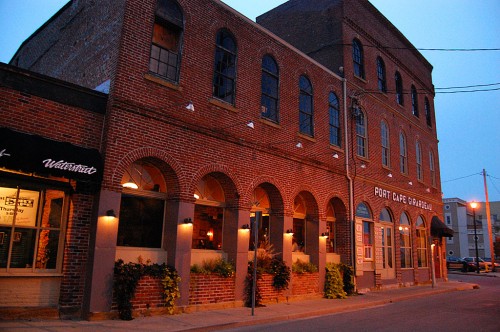 Harold Abernathy, Oscar Abernathy, Charles Wilson, Harry Lee and Maso Meacham, representing the Sportsman’s Club, 39 North Water, an organization seeking to help Negro teen-age youngsters, called on the city council, The Missourian reported Dec. 9, 1958, using distinctions that signal how segregated the city was going into the 60s.
Harold Abernathy, Oscar Abernathy, Charles Wilson, Harry Lee and Maso Meacham, representing the Sportsman’s Club, 39 North Water, an organization seeking to help Negro teen-age youngsters, called on the city council, The Missourian reported Dec. 9, 1958, using distinctions that signal how segregated the city was going into the 60s.
A Sunday night dance sponsored by the group was halted when there was a complaint. The council explained that city ordinance prohibits public dances on Sunday. If the organization was private, the said, did not sell tickets and held a party as a private organization, that was another matter.
The visitors said it was a private group designed to raise funds to provide recreation for teen-age Negro youths. Programs for the youths are held on Friday nights during the school year and on Tuesday and Friday in the summer, they said.
Caught fire in 1939
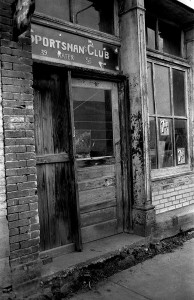 Cape’s downtown was threatened by fire when three business buildings caught fire, The Missourian reported Feb. 27, 1939. The blaze started on the second floor and involved the Co-op drug store, Fred Bark’s cafe, the Louis Suedekum cafe and beer parlor and a rooming house entrance on the Main Street side. On the Water Street side, were the Charles Young and Ben Edwards Negro cafes.
Cape’s downtown was threatened by fire when three business buildings caught fire, The Missourian reported Feb. 27, 1939. The blaze started on the second floor and involved the Co-op drug store, Fred Bark’s cafe, the Louis Suedekum cafe and beer parlor and a rooming house entrance on the Main Street side. On the Water Street side, were the Charles Young and Ben Edwards Negro cafes.
The paper said the fire apparently started on one of the Young Negro rooming houses, how or exactly where hadn’t been determined at the time of the writing.
Mr. and Mrs. Barks, who lived above their cafe, were momentarily trapped there. Mr. Barks, who hadn’t been feeling well, was in bed. Mrs. Barks rushed upstairs, using a rear stairway, then on fire, to call him. This was the only exit, and it was shut off by fire and smoke before they could escape. Firemen had to place a ladder on the front of the building to get them to safety.
The third floor of the Young building was mostly gutted and some damage was done to the second floor. Since the aerial shows that it was only two stories in the middle 60s, I’m guessing that the building lost its third story during its repair.

this was great. thanks for posting this.
Mrs. Barks was my aunt, and I’m amazed no one in the family ever told this story.
Here is a link to the original Missourian story with more detail.
This story reminds me of a club called “The Honeydripper” for negro or blacks the polite term for African-Americans during Cape’s segregated years) when I grew up in Cape. Could relate a story of a group of young whites to the Honeydripper, but best left untold.
Hotep,
My father Clyde Benson Sr. and my uncle David Hayes were members of the Sportsmans Club. I thought that meant they went duck hunting,bowling,playing baseball or something. I think though it was just a private club where Black men could get together, talk and drink in private without having anyone there who was dripping with hatred at them for having Beautiful Brown and Black Skin. He also was a member of the Sportsmans Club in Cairo after the one in Cape Ended He and Maso Meacham were gambling and drinking buddies. There was a neighborhood Poker club that rotated from home to home every week. My father, Maso Meacham, Dolphus Middlebrooks, Ralph Johnson, Robert Hubbard, Cornelious, perhaps Richard Morrison, and a few other whose names I can’t remember played weekly.
I used to be very frightened because I knew that you can’t win everytime you play and I dreaded the day when my dad would tell us he had lost and we would not be able to eat, or have electricity.
I never knew if that happened or not, because I never missed a meal. He also was never mean to my mother or me. Thanks to the Finch family I dressed better than most kids as Charlie and I were the same age and size back then. so I was given a lot of his hand me down clothes. To me they still looked new. Also I was an only child where most of the other Black families had two or more children. My parents were always able to bring home lots of food from the parties they served for Dr Grisham and Dimples, as well as the Finch’s and the Sheets. 🙂
So all in all, I was very blessed growing up despite the net of WS that surrounded all of us. 🙂
Oh Yes, my father was good friends with Mary and Ben Edwards. They had a club near where Port Cape is on water street. I remember Mary throwing me a couple of hot nickels that she kept on her heavy iron stove in the place. Juggling those Nickels until they cooled down was always a lot of fun for me.They were both good to kids as far as I could tell. Also dad was a regular at Johnny Youngs place down at Independence and Water street. He didn’t take me there. I guess the atmosphere was a little rougher there, but I never heard of much violence going on there. So we had at least two Black bars on Water street and of course there was Peoples Cafe on Good Hope,band a club in Smelterville called Porters.
So even though things were still mostly segregated back then, the Black folks were having a grand time with each other. 🙂
Thanks for showing pictures of Water street Ken. I remember the days when there was o sea wall and the river overflowed shutting down all of the businessess there. there would be sandbags on main street and people in rowboats trying to get around down there when it was underwater. Woolworths and their great Cashews that constantly rotated in that little device. Woolworths was where I bought my Buddy Holly record and all the other groups on 45rpm. I worked in the kitchen there for a while, but that’s another story. 🙂 Keep up the great work.
Unfortunately in another sixty years we will all be long gone unless our government makes developing things to extend life instead of just bombing and nuking everyone into submission wasting trillions of dollars on death, instead of spending our tax dollars designing way for people to live longer.
Amen-RA
Clyde,
Thanks for putting this piece in perspective.
I was a little surprised to see Black social club in the downtown area because the color line was so strictly enforced that Major Taylor, arguably the fastest cyclist in the world, was denied housing in a downtown hotel.
He was so disgusted that the promised lodging had been withdrawn that he pulled out of a race in Cape, which kept him from being the American champion. He was banned from racing and took his wheels to Europe.
You can read more about the injustice in this excerpt from Major Taylor: The Extraordinary Career of a Champion Bicycle Racer